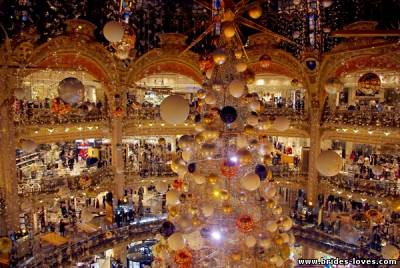01:35 Christmas | |
A Christmas carol (also called a noël, from the French word meaning "Christmas") is a carol (song or hymn) whose lyrics are on the theme of Christmas, and which is traditionally sung on Christmas itself or during the surrounding holiday season. Christmas carols may be regarded as a subset of the broader category of Christmas music. Christmas tree of Galeries LafayetteIt is tradition: a giant tree always sits under the beautiful Art Nouveau dome from November to January. The 2015Christmas tree is a metallic structure with gold and silver stars and meteorites. Four times a day at 12pm, 3pm, 4.30pm and 6pm the Christmas tree is the centre piece of an indoor light show. The first known Christmas hymns may be traced to fourth century Rome. Latin hymns such as Veni redemptor gentium, written by Ambrose, Archbishop of Mila In the ninth and tenth centuries, the Christmas "Sequence" or "Prose" was introduced in North European monasteries, developing under Bernard of Clairvaux into a sequence of rhymed stanzas. In the twelfth century the Parisian monk Adam of St. Victor began to derive music from popular songs, introducing something closer to the traditional Christmas carol. In the thirteenth century, in France, Germany, and particularly, Italy, under the influence of Francis of Assisi a strong tradition of popular Christmas songs in the native language developed. Christmas carols in English first appear in a 1426 work of John Awdlay, a Shropshire chaplain, who lists twenty five "caroles of Cristemas", probably sung by groups of 'wassailers', who went from house to house. The songs we know specifically as carols were originally communal songs sung during celebrations like harvest tide as well as Christmas. It was only later that carols begun to be sung in church, and to be specifically associated with Christmas. Carols gained in popularity after the Reformation in the countries where Protestantchurches gained prominence (as well-known Reformers like Martin Luther authored carols and encouraged their use in worship), this was the consequence of the fact that the Lutheran reformation warmly welcomed music. "Adeste Fideles" ("O Come all ye faithful") appears in its current form in the mid-18th century, although the words may have originated in the thirteenth century. The origin of the tune is disputed. The first appearance in print of "God Rest Ye Merry, Gentlemen", "The First Noel", "I Saw Three Ships" and "Hark! The Herald Angels Sing" was in Christmas Carols Ancient and Modern (1833) by William Sandys. Composers like Arthur Sullivan helped to repopularize the carol, and it is this period that gave rise to such favorites as "Good King Wenceslas" and "It Came Upon the Midnight Clear", a New England carol written by Edmund H. Sears and Richard S. Willis. Today carols are regularly sung at Christian religious services. Some compositions have words that are clearly not of a religious theme, but are often still referred to as "carols". For example, the sixteenth century song "A Bone, God Wot!" appears to be a wassailing song (which is sung during drinking or while requesting ale), but is described in the British Library's Cottonian Collection as a Christmas carol. As recently as 1865, Christmas-related lyrics were adopted for the traditional English folk song Greensleeves, becoming the internationally popular Christmas carol “What Child is This?”. Little research has been conducted on carol singing, but one of the few sociological studies of caroling in the early 21st century determined that the sources of songs are often misunderstood, and that it is simplistic to suggest caroling is mostly related to Christian beliefs, for it also reinforces preservation of diverse national customs and local family traditions.
| |
|
| |
| Total comments: 0 | |
